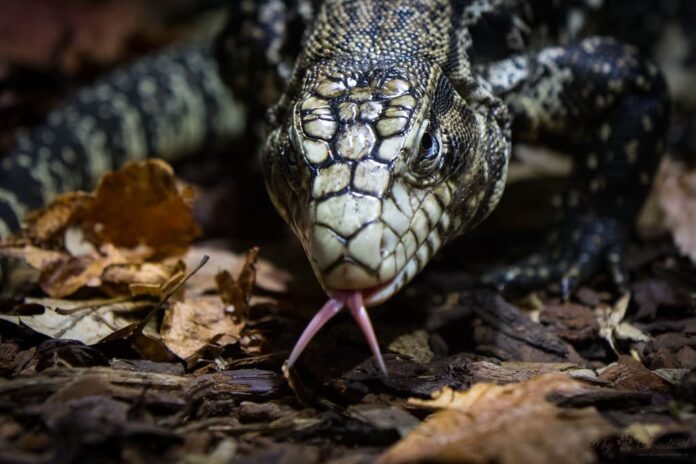Have you ever wondered why some animals have forked tongues? A forked tongue is a tongue that splits into two distinct tines at the tip which is common among many reptile species. Reptiles with forked tongues rely on flicking out their tongues to collect environmental information around them. Every flick receives odor and minuscule moisture particles that are floating in the air. Forked tongues help the animals to tell objects on both the right and left sides at the same time. That helps them with finding and hunting their prey. Since there are many reptiles with forked tongues, I only choose the carnivorous ones which you will find below.
1Caiman Lizard
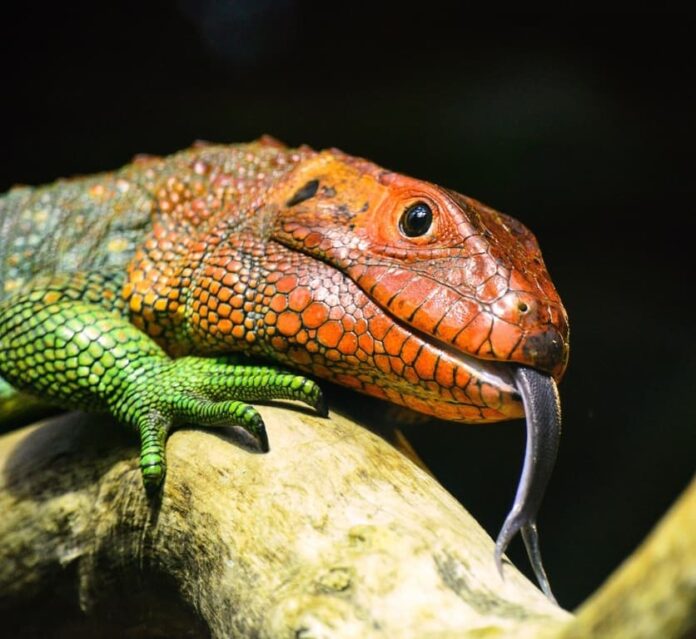
This lizard species got its name from the appearance resemblance to the caiman crocodile of South America. The caiman lizard spends most of its time either in or around the water. So it has adapted in ways that help it to live an aquatic lifestyle more successfully. That is why these lizards have long flattened tails that help them to steer while swimming easily. With their large size and lifestyle, caiman lizards don’t have too many predators.
With their forked tongues, caiman lizards can locate prey easily using their ability to smell from the tongue. Caiman lizards are large carnivorous predators that only hunt other animals in order to gain their nutrients. That is why snails are the primary source of food for these lizards. At the same time, they also feed on invertebrates like insects and crabs as well. Sometimes they also go for larger animals like fish, rodents, and amphibians.
Fun Fact: Caiman lizards have third eyelids that act like a goggle when they submerge in the water.
2Komodo Dragon
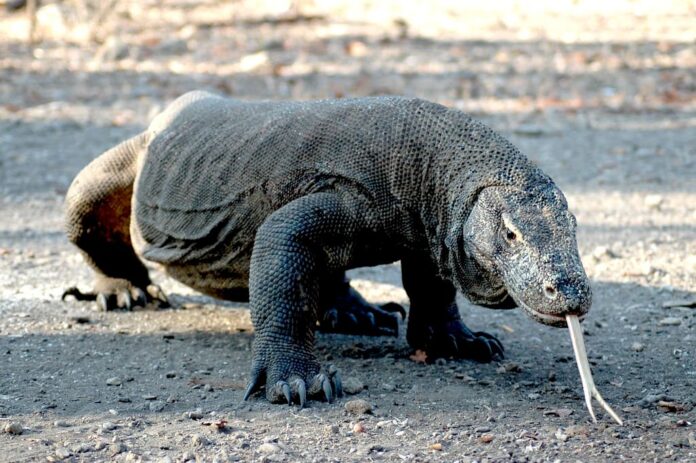
Komodo Dragons are the largest lizards in the world, and they can grow as long as 3 meters in length. Their skin is rough and durable, and they have very long claws and a large muscular tail. Komodo dragons have great vision, and they can see objects are far as 300 meters. At the same time, they are also very fast as well. However, these dragons prefer to hunt by stealth; waiting for hours until prey crosses their path.
The Komodo dragons use their forked tongues as their primary food detector. The tongue will sample the air, and it collects the smell for the dragon. If the left tongue tip has a more concentrated smell, they know that their prey is approaching from the left. Komodo dragons have poor eyesight and a sense of hearing, so they hunt during the day relying entirely on smell. These carnivorous dragons feed on a variety of prey like water buffalo, deer, pigs, and any carrion they can find.
The bites from a Komodo dragon contains venom that can kill the prey within 24 hours due to blood poisoning if not instantly. That is because their saliva contains 50 strains of bacteria, and their sharp serrated teeth are the bacteria delivery methods. However, those bites won’t affect them at all during their fights with other dragons. They are simply immune to bacteria from their own saliva. The attacks from Komodo dragons on humans are rare, but they have also been responsible for several human fatalities as well.
Fun Fact: Komodo dragons are great swimmers, and they can swim from one island to another.
3Monitor Lizard
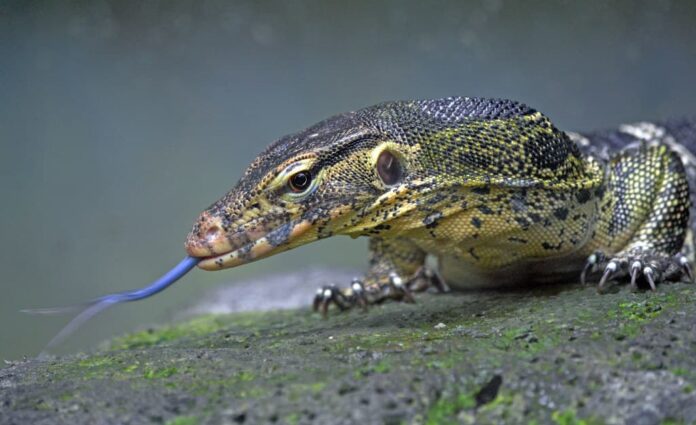
Monitor lizards have massive bodies and powerful legs, and most species have strong claws on their feet. All monitor lizards can climb well, except the largest ones. Just like crocodiles, monitor lizards also have long and powerful tails that they flail as a potent weapon. The tail of a monitor lizard is usually about twice as long as the body.
Monitor lizards have long forked tongues with a bifurcated tip that is highly sensitive to smell and taste. They extend their tongue to pick up scent chemicals, and these active predators hunt during the day. Monitor lizards are mostly carnivorous, and feed on various animals, eggs, and carrion. These lizards can run quickly to chase down prey, and they can also swim very well.
When threatened, monitor lizards can be very aggressive. They can inflict painful bites and scratches, and they can also secrete venom as well. Their venom is potent to small animals and infants but not to humans. Large monitor lizards are strong enough to crush human bones, but they never attack first unless provoked. Just make sure you keep the distance from them, and you will be fine.
Fun Fact: Monitor lizards can walk underwater, and they can also use their tongue to smell underwater.
4Tegu
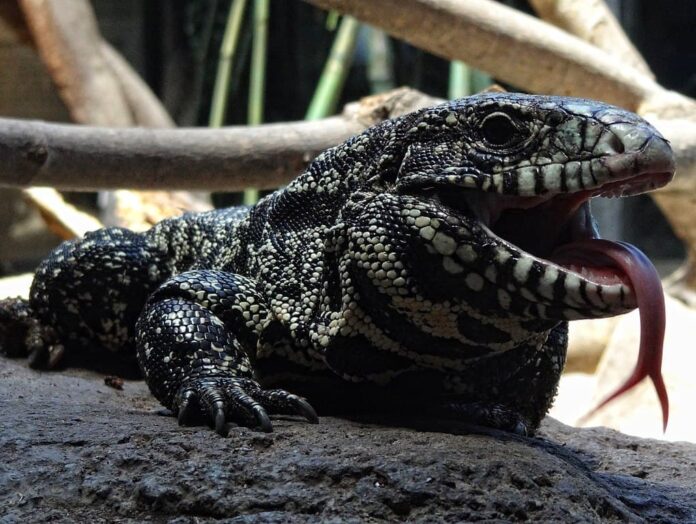
This is another type of large lizards with forked tongues that is native to South America. Although they resemble monitor lizards, they are only distantly related to each other. The body of a tegu is covered with beaded skin, and they have muscular bodies, especially the males. Tegus are terrestrial animals since they spend most of their life on the ground, but they are also excellent swimmers. These lizards can dive and spend up to 22 minutes under the water without returning to the surface to breathe.
The unique trait of tegus is that they are omnivores, so they feed on both meat and plants. They eat small rodents, insects, eggs, amphibians, mollusks, birds, seeds, berries, and fruit. These lizards are also capable of destroying the beehive as well because they like to eat honey. Compared to most carnivorous lizards, this one is actually quite friendly and docile. That is why they are also popular as pets as well.
Tegus are very intelligent animals, and they are able to recognize their owners in captivity. Tegus often form a close bond with their owner, and they require human love and affection. Sometimes they rather spend quality time with their owners instead of eating. However, they show more aggressive behavior if they are not handled regularly. Their bites can be painful and damaging although without venom due to their strong jaws and sharp teeth. If you want a pet tegu, make sure you have enough time to be with them.
Fun Fact: Some tegu species are able to eat venomous snakes and frogs without visible side effects.
5Whiptail
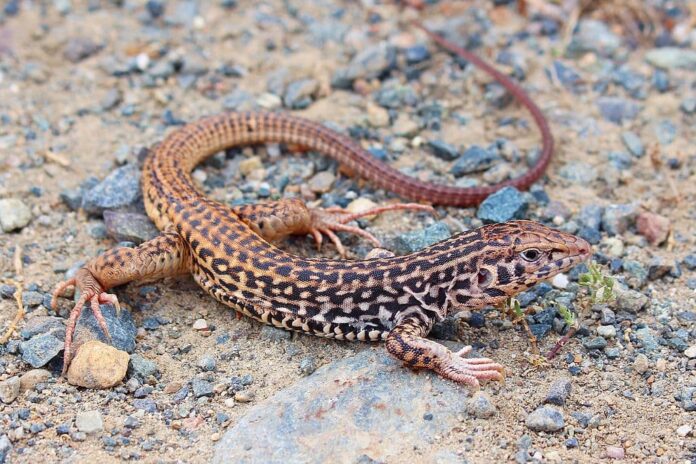
Whiptail lizards are not as large as the others above, but they also have forked tongues as well. These lizards use their forked tongues to sense for prey they usually feed on such as spiders, crickets, antlions, beetles, etc. Also, they have long slender bodies with extremely long tails. These lizards have large rectangular scales that form distinct transverse rows ventrally, and generally small granular scales dorsally. Almost all of the whiptail species are terrestrial (only a few are semi-aquatic), and they are diurnal. The whiptail lizards are very commonly seen especially around trees, bushes, and even household. This species is not dangerous although they look quite scary and intimidating to some.
Fun Fact: Whiptail lizards are asexual, meaning they are a female-only species; hence the common nickname Lesbian Lizards.
Related Post: Animals With The Longest Tongues

